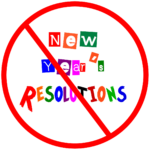That is not to say I am against making changes or improvements.
But… ….a major reality of the tradition of making New Year’s resolutions is not achieving the resolutions you make. When you make New Year’s resolutions, you are setting yourself up to fail.
Resolutions – multiple, more than one.
A change in behaviour or thinking is not realized instantly or quickly, it requires time and effort. A change in behaviour or thinking is also not a task you can multitask on. Not allowing for the time and effort and/or not focusing on a single change is setting yourself up to fail.
If there is a behaviour I want to change or a behaviour I want to add and I am determined to achieve the change – I want to maximize, not minimize, the likelihood I will be successful.
Being successful requires planning.
An important part of an effective plan to accomplish any New Year’s resolution is an understanding of what it takes to achieve that resolution.
If you seek to make an exercise program a part of your life you need to be aware that it takes 3 months to establish a new habit. Your plan needs to ensure you unfailingly follow your plan for those 12 weeks. I am aware that some experts assert it takes less that 12 weeks to establish a habit, but if you start by going with the shorter period how committed are you to achieving your goal? If you are choosing the easiest plan, how likely are to achieve your goal?
The most important aspect of constructing a plan that successfully achieves your goal is understanding yourself; an understanding that requires the discomfort of not lying, rationalizing or making excuses to yourself.
I always envied my brother his seeming ease in social situations. Although I recognize now that his ease was an assumption of mine and that the only way I could know whether he was at ease or had actually felt stressed would have required a conversation on that topic.
When mental health challenges consumed my life by impairing my ability to function and left me homeless in Abbotsford, the only effective way to break out of what for most is a cycle of homelessness was to face and deal with my mental hygiene. A processed that required getting to know myself and to know myself I needed to be brutally honest with myself.
The process of knowing and understanding myself included learning how to determine what my core beliefs were and how to change those beliefs where necessary. That was not a simple process and therefore neither a quick nor easy process.
Part of my plan for becoming comfortable in social situations was to deal with my abject terror of public speaking. At that time the mere thought of public speaking triggered a panic attack and any attempt at public speaking would have me curled in the foetal position under a table.
I found the only effective approach to dealing with public speaking was to eliminate any chance to rationalize, excuse or avoid speaking publicly. Although I am more comfortable with public speaking these days, my rule, vis-à-vis public speaking, is to not allow myself any if ands or buts by saying yes.
Interestingly, my policy of ‘just say yes’ to public speaking lead to ‘write it and send it’ and/or ‘write it and post it’.
For decades I said to myself ‘I should write a letter to the editor’ I should write an article addressing that issue’ and never did [could].
Part of being creatively maladjusted is that your thoughts on matters have the ability to piss off the left, right and center – all at the same time on the same issue.
Despite people acting as though matters are black and white, the complexity the involvement of humans brings means there is little black or white and numerous shades of grey. When you are creatively maladjusted you see all the grey and all the shades of grey nobody sees or wants to see.
When you are creatively maladjusted you hear a lot of “I don’t want to hear it” from those who do not want what they believe or believe they know challenged. The more emotion in an issue, the less people tolerate their perceptions and prejudices being challenged.
It took time and great effort to be comfortable seeing the reality so few see.
Change is never easy so why would I make change harder by associating it with a tradition of failure?

